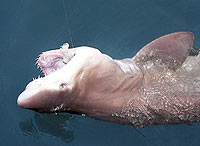
|
||||||||
|
Sharks and rays belong to the group of fish called chondrichthyes or cartilaginous fish. This is a very diverse group which also includes sawfishes, skates and elephant fish. One of the main differences between cartilaginous fish such as sharks, and finfish, such as tuna, is that they have a skeleton made of light and flexible cartilage. Shark cartilage is similar to the cartilage in our bodies that helps give our noses and ears their shape. Australia has one of the richest and most unique shark and ray faunas of the world. We have over 160 shark species and more than 110 ray species and more than half of these are only found in Australian waters, no where else in the world. |
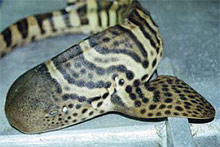 Zebra shark. (courtesy CSIRO Marine and Atmospheric Research) |
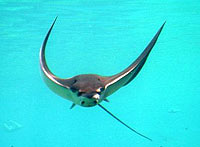 Stingray (courtesy of Valerie Lita via Flickr) |
Sharks and rays live in all parts of the ocean, from coastal waters to the open ocean, from shallow tidal areas to the ocean depths of more than 2000m. As they live in so many parts of the ocean they are caught by many fisheries around the world. Sharks and rays are also impacted by other human activities, such as pollution and habitat loss, due to coastal development, and environmental changes. In Australia, sharks and rays are taken by commercial, Indigenous and recreational fishers and are also caught in shark control programs for bather protection. There are seven recognised commercial shark fisheries in Australia which target school shark, gummy shark, dusky shark, whiskery shark, sandbar shark, blacktip shark and spot-tail shark. Shark is often sold in stores as flake. |
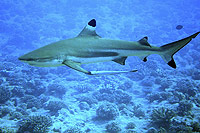 Blacktip Reef Shark (courtesy of David Mason via Flickr) |
Sharks are also caught by commercial fishers which are targeting other species, such as finfish, and may be kept to be sold. This is called byproduct. Sharks and rays are also taken as bycatch in a wide range of fisheries, from trawl fisheries to hook and line fisheries. In this case the sharks and rays are usually thrown back into the ocean and, depending on how the sharks and rays were caught, they may be returned to the water alive or dead. |
Why are we concerned about sharks?
Sharks and rays are valued by the Australian community because of the important role they play in maintaining healthy marine ecosystems and their cultural significance to Indigenous and other groups. There is worldwide concern over the bycatch of sharks and rays in fisheries. In most fisheries this bycatch is unmanaged and not recorded. However, worldwide the amount of shark and ray bycatch is estimated to be as high as the known targeted shark and ray catch. Very little is known about bycatch species and what impact the bycatch is having on the size and health of their populations. One of the few recorded cases of near-extinction of a marine fish has been the barndoor skate - a large skate which rows to 1.5 m long, and was once common in Northwest Atlantic waters. It is thought to be near extinction because it has been caught as bycatch in finfish trawls and scallop dredging. |
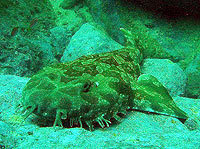 Wobbegong shark (courtesy of Wayne Atkinson via Flickr) |
Shark and ray populations can take a long time to recover if ever their numbers are reduced because they usually have a smaller number of offspring and are generally longer-lived than most finfish and marine invertebrates (squid, shellfish, prawns). For this reason, some sharks and rays need careful management to ensure their capture as bycatch does not threaten populations.
Some species of shark and ray are migratory, swimming large distances across open oceans between Australian waters and other countries. These species may be impacted by human activities on the open oceans, such as oceanic fishing fleets or marine debris, or by fishing in neighbouring countries. Hence, it is important to protect these species globally. In Australia some sharks, including the Whale shark (the biggest fish in the ocean), Speartooth shark, and the population of the Grey Nurse shark on the east coast of Australia, are already listed as threatened species because there is concern about their low numbers or declining populations. The listing of the migratory Whale shark, which can travel over 12,000 km in a year, as threatened is due to impacts and population declines seen in Asian countries. |
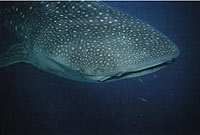 Whale shark (courtesy of Pascal Kwakman via Flickr) |
How are Australian fisheries trying to prevent shark bycatch?
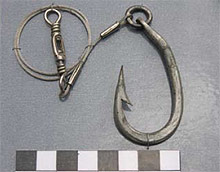 A longline hook with wire leader, the wire makes it harder for an animal, such as a shark to bite through the line if caught. Wire leaders are banned in some Australian fisheries to reduce the bycatch of sharks. (courtesy BRS) |
Target shark fisheries in Australia are managed with the aim of ensuring that they remain sustainable. This includes restricting the type, size and number of sharks that can be taken for sale. There are also restrictions on the number of fishers, fishing areas and types of fishing gear that can be used. Other measures, such as the use of bycatch reduction devices, turtle excluder devices (TEDs) and bans on the use of certain types of nets such as monofilament gillnets, can also reduce the chance of catching non-target sharks and rays. |
For example, the introduction of TEDs into Australian tropical prawn trawl fisheries has also benefited large sharks and rays. TEDs are designed to reduce the catch of turtles by guiding the turtles across a large grid placed in the net and out through an opening in the net. The target prawns pass through the grid and still get caught. The TED works in the same way for the large sharks and rays as it does for the turtles, excluding over 85% of large sharks and rays. This benefits the sharks and rays as they don’t get caught. The fishers also benefit as they don’t have to deal with these large and potentially dangerous animals on board their boats. It also reduces crushing of the prawn catch by these large animals, increasing the value of the catch. |
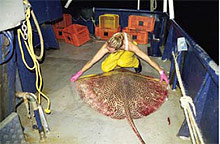 Skippers and crew members in the Northern Prawn Fishery help record information about shark and ray bycatch for scientists and fishery managers. (courtesy CSIRO Marine and Atmospheric Research) |
 Grey nurse shark (courtesy of Richard Barnett via Flickr) |
At present there is little information on the shark species taken by recreational fisheries and there is concern about the possible level of bycatch of protected species such as grey nurse sharks. To help ensure the management of shark and ray species is sustainable, Australia has developed a National Plan of Action for the Conservation and Management of Sharks (Shark-plan). The Shark-plan aims to improve the conservation and management of sharks and rays by enhancing management practices in targeted shark fisheries, as well as fisheries where they are caught as bycatch. The plan is available to the public and can be sourced via the link below. |
|
 Reef shark. (courtesy DEW) |
Another issue of significant concern for Australia is the worldwide problem of shark finning. Finning is the practice where the fins of a shark are removed while the rest of the shark is discarded at sea, a practice which is illegal in Australian fisheries. Foreign fishers illegally enter Australia’s northern waters to catch sharks to supply the large demand for fins in eastern Asia. The illegal finning could be causing serious problems for some northern shark populations and the Australian Government is working to catch illegal fishers before it is too late for some species and to preserve Australia’s shark stocks. |
• Department of Agriculture, Fisheries and Forestry – Shark-plan:
www.daff.gov.au/sharkplan• Department of the Environment and Water Resources (DEW) - Sharks:
www.deh.gov.au/coasts/species/sharks/index.html• International Plan of Action for the Conservation and Management of Sharks:
www.fao.org/figis/servlet/static?dom=org&xml=ipoa_sharks.xml• Australian Fisheries Management Authority – Managing Bycatch:
www.afma.gov.au/environment/bycatch/default.htm• CSIRO Marine Research – Sharks and Rays:
www.marine.csiro.au/LeafletsFolder/53guide/53.html
Acknowledgements
This information sheet has been compiled with the assistance of Dr Terrence Walker, Primary Industries Research Victoria, and using the expertise and support from a number of sources. Sharks and Rays of Australia by P.R. Last and J.D. Stevens; The National Plan of Action for the Conservation of Sharks and Rays, produced by the Department of Agriculture Fisheries & Forestry; Near extinction of a widely distributed fish in Science by J.M. Casey and R.A. Myers; Assessment and improvement of TEDs and BRDs in the NPF, produced by CSIRO Marine and Atmospheric Research.

